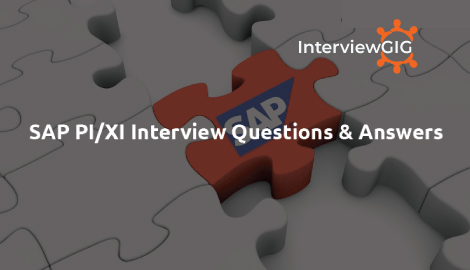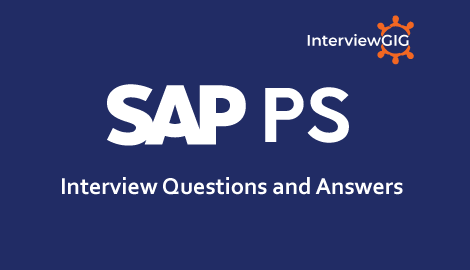What all data sources you have used to acquire data in SAP BW system?
- SAP systems (SAP Applications/SAP ECC)
- Relational Database (Oracle, SQL Server, etc.)
- Flat File (Excel, Notepad)
- Multidimensional Source systems (Universe using UDI connector)
- Web Services that transfer data to BI by means of push
When you are using SAP BI7.x, you can load the data to which component?
In BW 3.5, you can load data in Persistence Staging Area and also in targets from source system but If you are using SAP BI 7.0 data load should be restricted to PSA only for latest versions.
What is an InfoPackage?
An InfoPackage is used to specify how and when to load data to BI system from different data sources. An InfoPackage contains all the information how data is loaded from source system to a data source or PSA. InfoPackage consists of condition for requesting data from a source system.
Note that using an InfoPackage in BW 3.5, you can load data in Persistence Staging Area and also in targets from source system but If you are using SAP BI 7.0 data load should be restricted to PSA only for latest versions.
What is extended Star schema? Which of the tables are inside and outside cube in an extended star schema?
In Extended Star schema, Fact tables are connected to Dimension tables and dimension table is connected to SID table and SID table is connected to master data tables. In Extended star schema you have Fact and Dimension tables are inside the cube however SID tables are outside cube. When you load the transactional data into Info cube, Dim Id’s are generated based on SID’s and these Dim id’s are used in fact tables.
How extended Star schema is different from Star schema?
In Extended Star schema one fact table can connect to 16 dimensions tables and each dimension table is assigned with 248 maximum SID tables. SID tables are also called Characteristics and each characteristic can have master data tables like ATTR, Text, etc.
In Star Schema, Each Dimension is joined to one single Fact table. Each Dimension is represented by only one dimension and is not further normalized.
Dimension Table contains set of attributes that are used to analyze the data.
What is an InfoObject and why it is used in SAP BI?
Info Objects are known as smallest unit in SAP BI and are used in Info Providers, DSO’s, Multi providers, etc. Each Info Provider contains multiple Info Objects.
InfoObjects are used in reports to analyze the data stored and to provide information to decision makers.
What are the different categories of InfoObjects in BW system?
Info Objects can be categorized into below categories −
- Characteristics like Customer, Product, etc.
- Units like Quantity sold, currency, etc.
- Key Figures like Total Revenue, Profit, etc.
- Time characteristics like Year, quarter, etc.
What is the use of Infoarea in SAP BW system?
Info Area in SAP BI are used to group similar types of object together. Info Area are used to manage Info Cubes and Info Objects. Each Info Objects resides in an Info Area and you can define it a folder which is used to hold similar files together.
How do you access to source system data in BI without extraction?
To access data in BI source system directly. You can directly access to source system data in BI without extraction using Virtual Providers. Virtual providers can be defined as InfoProviders where transactional data is not stored in the object. Virtual providers allow only read access on BI data.
What are different types on Virtual providers?
- VirtualProviders based on DTP
- VirtualProviders with function modules
- VirtualProviders based on BAPI’s
What is the use of Transformation and how the mapping is done in BW?
Transformation process is used to perform data consolidation, cleansing and data integration. When data is loaded from one BI object to other BI object, transformation is applied on the data. Transformation is used to convert a field of source into the target object format.
Transformation rules − Transformation rules are used to map source fields and target fields. Different rule types can be used for transformation.
What is InfoObject catalog?
InfoObjects are created in Info Object catalog. It is possible that an Info Object can be assigned to different Info Catalog.
What is the use DSO in BW system? What kind of data is stored in DSOs
A DSO is known as storage place to keep cleansed and consolidated transaction or master data at lowest granularity level and this data can be analyzed using BEx query.
A DataStore object contains key figures and charactertics fields and data from DSO can be updated using Delta update or other DataStore objects or master data. DataStore objects are commonly stored in two-dimensional transparent database tables.
What are the different components in DSO architecture?
Activation Queue: This is used to store the data before it is activated. The key contains request id, package id and record number. Once activation is done, request is deleted from the activation queue.
Active Data Table: This table is used to store current active data and this table contains the semantic key defined for data modeling.
Change Log: When you activate the object, changes to active data re stored in change log. Change log is a PSA table and is maintained in Administration Workbench under PSA tree.
Explain the structure of direct update DSO?
one table for active data and no change log area exists. Data is retrieved from external systems using API’s.
Below API’s exists:
RSDRI_ODSO_INSERT: These are used to insert new data.
RSDRI_ODSO_INSERT_RFC: Similar to RSDRI_ODSO_INSERT and can be called up remotely.
RSDRI_ODSO_MODIFY: This is used to insert data having new keys.For data with keys already in the system, the data is changed.
RSDRI_ODSO_MODIFY_RFC: Similar to RSDRI_ODSO_MODIFY and can be called up remotely.
RSDRI_ODSO_UPDATE: This API is used to update existing data.
RSDRI_ODSO_UPDATE_RFC: This is similar to RSDRI_ODSO_UPDATE and can be called up remotely.
RSDRI_ODSO_DELETE_RFC: This API is used to delete the data.
What is write optimized DSO?
In Write optimized DSO, data that is loaded is available immediately for the further processing.
Where do we use Write optimized DSO?
Write optimized DSO provides a temporary storage area for large sets of data if you are executing complex transformations for this data before it is written to the DataStore object. The data can then be updated to further InfoProviders. You only have to create the complex transformations once for all data.
Write-optimized DataStore objects are used as the EDW layer for saving data. Business rules are only applied when the data is updated to additional InfoProviders.
What is a temporal join?
Temporal Joins: are used to map a period of time. At the time of reporting, other InfoProviders handle time-dependent master data in such a way that the record that is valid for a pre-defined unique key date is used each time. You can define Temporal join that contains atleast one time-dependent characteristic or a pseudo time-dependent InfoProvider.
Where do we use InfoSet in BI system?
Infosets are used to analyze the data in multiple InfoProviders by combining master data charactertics, DataStore Objects, and InfoCubes.
You can use temporal join with InfoSet to specify a particular point of time when you want to evaluate the data.
You can use reporting using Business Explorer BEx on DSO’s without enabling BEx indicator.
What are the different type of InfoSet joins?
- Inner Join
- Left Outer Join
- Temporal Join
- Self-Join
What is the use of InfoCube in BW system?
InfoCube is defined as multidimensional dataset which is used for analysis in a BEx query. An InfoCube consists of set of relational tables which are logically joined to implement star schema. A Fact table in star schema is joined with multiple dimension tables.
You can add data from one or more InfoSource or InfoProviders to an InfoCube. They are available as InfoProviders for analysis and reporting purposes.
What is the structure of InfoCube?
An InfoCube is used to store the data physically. It consists of a number of InfoObjects that are filled with data from staging. It has the structure of a star schema.
In SAP BI, an Infocube contains Extended Star Schema as shown above.
An InfoCube consists of a fact table which is surrounded by 16-dimension tables and master data that is lying outside the cube.
Is it possible to convert a standard InfoCube to real time InfoCube?
To convert a standard InfoCube to real time InfoCube, you have two options
- Convert with loss of Transactional data
- Conversion with Retention of Transaction Data
Can you convert an InfoPackage group into a Process chain?
Yes, Double Click on the info package grp → Process Chain Maintenance button and type in the name and description.
When you define aggregates, what are the available options?
- H Hierarchy
- F fixed value
- Blank
What do you understand by Start and update routine?
Start Routines: The start routine is run for each Data Package after the data has been written to the PSA and before the transfer rules have been executed. It allows complex computations for a key figure or a characteristic. It has no return value. Its purpose is to execute preliminary calculations and to store them in global Data Structures. This structure or table can be accessed in the other routines. The entire Data Package in the transfer structure format is used as a parameter for the routine.
Update Routines:They are defined at the InfoObject level. It is like the Start Routine. It is independent of the DataSource. We can use this to define Global Data and Global Checks.
What is the use of Rollup?
This is used to load new Data Package into the InfoCube aggregates. If we have not performed a rollup then the new InfoCube data will not be available while reporting on the aggregate.
What is Partition of an InfoCube?
It is the method of dividing a table for report optimization. SAP uses fact file partitioning to improve performance. We can partition only at 0CALMONTH or 0FISCPER. Table partitioning helps to run the report faster as data is stored in the relevant partitions. Also, table maintenance becomes easier.
What is the use of Navigational attributes?
Navigational attribute is used for drilling down in the report.
What is the use of DB connection in SAP BW data acquisition?
DB connect is used to define other database connection in addition to default connection and these connections are used to transfer data into BI system from tables or views.
To connect an external database, you should have below information −
- Tools
- Source Application knowledge
- SQL syntax in Database
- Database functions
What is UD connect in SAP BW system? How does it allow reporting in BI system?
Universal data UD connect allows you to access Relational and multidimensional data sources and transfer the data in form of flat data. Multidimensional data is converted to flat format when Universal Data Connect is used for data transfer.
UD uses J2EE connector to allow reporting on SAP and non-SAP data. Different BI Java connectors are available for various drivers, protocols as resource adapters −
- BI ODBO Connector
- BI JDBC Connector
- BI SAP Query Connector
- XMLA Connector





